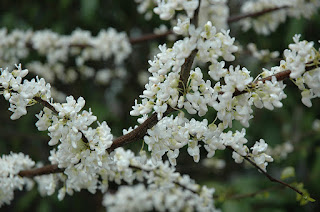Thank goodness the latest nor’easter missed Massachusetts. There’s still snow on the ground, though. I’m itching to get outside and start spring gardening, but this snow is holding me up.
 |
| Snow still hanging around earlier this week |
Kevin Newman and his arborist team came by Wednesday to prune broken branches out of a white pine near the house. They’re working flat out after three storms this month that have brought down trees and countless limbs. Luckily they managed to squeeze in my small job at the end of the day. They ran the pine branches through the chipper and left a big pile of wood chips in the driveway, as I’d requested.
 |
| Wood chips! |
This should be just the right time for spreading those chips on paths and around trees and shrubs as mulch. But I can’t do it until the snow melts and the ground dries out a bit. I don’t want to compact the wet soil by tramping over it with a wheelbarrow.
It’s also the right time to prune shrubs before the leaves show.
 |
| Without leaves you can see what you're pruning |
I did some pruning during a warm spell in February and filled up the garage with yard waste bags. I have new tools I’m dying to try, ratchet pruners and loppers. My wrist fracture has healed, but my grip strength hasn’t returned yet. These tools should allow me to make pruning cuts with less effort, if only I can get out there and try them.
 |
| Adaptive pruning tools require less strength |
It’s traditional to plant peas around St. Patrick’s Day. I’d like to get the seeds into the ground by early April. They enjoy cool weather, as do lettuce and arugula. I want to sow a first row of greens soon. Let’s hope the snow on the vegetable bed melts within a couple of weeks.
Last fall I optimistically planted a lot of spring-blooming bulbs in one large pot. I’d read you could set several levels of bulbs in the same container. There’s a layer of tulip bulbs at the bottom, with daffodils in the next layer and grape hyacinths above them. The pot has been in the cool basement, covered with wire screening to keep out hungry mice with a taste for tulip bulbs. Now hopeful sprouts are pushing at the screen.
 |
| Potted bulbs need to get outside |
I should be moving the pot outdoors, but I’m afraid the weather is too cold. I may have to move it inside and out as the temperature fluctuates. To bloom well, the plants should be outdoors.
And what about all the seedlings that are sprouting under lights? Eventually I’ll need to move them too outside to get them used to sunlight. Will spring have arrived by then?
 |
| Borage and basil will need to move outside |
 |
| Snowdrops unfazed by a foot of snow last week |























